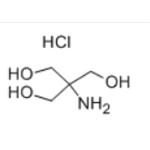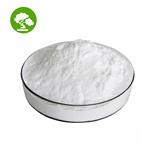What is Tris hydrochloride?
Sep 12,2023
Description
Tris hydrochloride, also known as Tris-HCl, is a white crystalline powder. Its molecular formula is C4H12ClNO3, which is a hydrochloride formed by Tris and hydrochloric acid. As a commonly used buffer, Tris-HCl buffer solutions are widely used in biochemistry and molecular biology to maintain stable pH values for biomolecules such as nucleic acids and proteins[1].
Tris-HCl and Tris
Tris-HCl is an acidic buffer, mainly used to prepare buffers with a physiological range of 7.3 ~ 7.5. Tris hydrochloride can be prepared by 2-amino-1,3-propanedio with 2-amino-1,3-propanedio. Tris is also called tris base. As a weakly alkaline solution, it has a pKa of 8.1 at 25 °C. Its effective buffer pH range is between 7.0-9.2, and the pH of the prepared aqueous solution is around 10, and its pH is often adjusted by adding hydrochloric acid. During experiments, it is often used at concentrations ranging from 10 mM to 100 mM.
Application of Tris-HCl
Studies have shown that tris-HCl could essentially completely dissociate in water. The mobility of the Tris· H+ ion was found to be considerably smaller than that of the alkali metal cations[2]. In biological research, Tris-HCl can be used to handle conventionally fixed chromosomes[3]. Liu et al. studied the effects of Tris-HCl, HEPES, and NaHCO3/CO2 on the corrosion behavior of pure Zn by impregnation test and electrochemical method. Based on different buffer systems with different pH control capacities, tris-HCl can be used to study the effect of pH on corrosion products. Tris-HCl inhibited corrosion product precipitation and increased corrosion rate in two corrosion media. Saeki et al. found that Tris-HCl can affect the adsorption of DNA by soil particles, so attention should be paid to the use of Tris-HCl when studying the adsorption of extracellular DNA molecules by soil particles[4].
References
[1] Lee S, et al. High-precision THz Dielectric Spectroscopy of Tris-HCl Buffer. Journal of the Optical Society of Korea, 2016; 20: 431-434.
[2] Bhanu P, et al. Application of Tris-HCl Allows the Specific Labeling of Regularly Prepared Chromosomes by CRISPR-FISH. Cytogenetic and Genome Research, 2020; 160: 156–165.
[3] Liu X, et al. Comparative studies of Tris-HCl, HEPES and NaHCO3/CO2 buffer systems on the biodegradation behaviour of pure Zn in NaCl and SBF solutions. Corrosion Science, 2019; 157: 205-219.
[4] Saeki K, et al. Effect of Tris-HCl Buffer on DNA Adsorption by a Variety of Soil Constituents. Microbes and Environments, 2011; 26: 88-91.
- Related articles
- Related Qustion
- Tris Hydrochloride: Preparation Method, Precautions, Advantages and Limitations May 10, 2024
Tris Hydrochloride is widely used in biochemistry for its versatile pH range and compatibility. Precautions include pH control and avoiding interference, despite limitations.
- Tris Hydrochloride: Versatile Buffer Compound in Biological Research Jan 5, 2024
Tris hydrochloride is is a white crystalline powder used buffer in scientific experiments with adverse effects on neuro-muscular transmission in smooth and cardiac muscle.
As a component of the extracellular matrix, HA is widely used in cosmetology, drug delivery, and disease detection.....
Sep 12,2023Biochemical EngineeringTungsten trioxide is an efficient photocatalyst, generating hydroxyl radicals for the degradation of antibiotics in wastewater.....
Sep 13,2023APITRIS hydrochloride
1185-53-1You may like
- The toxicity of Triethylene glycol
May 14, 2024
- Is 1,4-benzoquinone a toxicity compound?
May 11, 2024
- The Synthesis method and Toxicity of 18-Crown-6
May 10, 2024
TRIS hydrochloride manufacturers
- TRIS hydrochloride
-

- $25.00 / 1kg
- 2024-05-17
- CAS:1185-53-1
- Min. Order: 1kg
- Purity: 99%
- Supply Ability: 8000kg
- TRIS hydrochloride
-

- $0.00 / 25kg
- 2024-04-12
- CAS:1185-53-1
- Min. Order: 1kg
- Purity: 99%
- Supply Ability: 2000ton
- Tris HCL
-

- $23.50 / 25kg
- 2024-02-20
- CAS:1185-53-1
- Min. Order: 450kg
- Purity: ≥99.5%
- Supply Ability: 300tons




